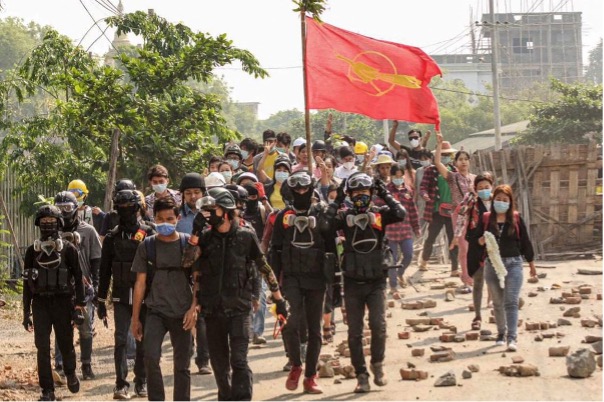13th April 2021
The intensity of action and counter action is hotting up. The protesters are changing tactics and slowing down the mass demonstrations in Yangon and Mandalay to avoid unnecessary loss of life. The Civil Disobedience movement is beginning to bite and that is where the anti-coup action is concentrated. The authorities have started to raid the homes of workers and attempt to convince them to return to work. Where people aren’t home, they have taken the families away to interrogate them as to their whereabouts, and of course inflict maximum psychological damage.
The action out in the provinces is taking a more violent turn. People are now using hunting rifles and catapults to “snipe” back at the Tatmadaw and the police. This is evident in Sagaing division where the people have inflicted casualties on the military, and they have managed to upgrade their weaponry to include military standard rifles and even grenades and RPGs. Sagaing is a division that has been relatively peaceful and has no Ethnic Armed Organisation operating within its borders. As a result, it has had a weak Tatmadaw presence. The Junta are now moving more troops into the region but of course, this will weaken its response-ability in the more sensitive regions. The EAOs in these regions have consequently upped their action and this has inflicted more casualties on the police and Tatmadaw.
There is a danger of refugees in their thousands spilling over the borders into Thailand and China. This is becoming a major problem for China as this will have an unsettling effect on the Chinese population and upset a lot of Chinese smugglers. There is a real danger of Myanmar becoming a failed state in a state of perpetual unrest and conflict.
Fighting broke out between various ethnic armed groups and the Myanmar military at several locations in the country’s north and northeast on Monday, resulting in heavy casualties to the military, including the death of a battalion commander, as well as the reported capture of some of their soldiers.
Fierce clashes between the Kachin Independence Army (KIA) and the Tatmadaw (Myanmar military) took place around Dokphoneyan in Kachin State’s Momauk Township. Tensions have been rising since the KIA seized the Alaw Bum base on March 25 near the Chinese border, which was previously occupied by the Tatmadaw.
KIA information officer, Colonel Naw Bu told The Irrawaddy that the Tatmadaw launched several airstrikes over four days in their efforts to recapture the base from the KIA.
A KIA official on the ground said many soldiers, including the battalion commander of the Tatmadaw’s light infantry Battalion No. 387, were reportedly killed by the KIA during the fighting on Monday.
He said that the KIA also captured eight Myanmar military soldiers.
A local resident said that six bombs landed in Chinese territory during the airstrikes.
He said that no one was injured on the China side as the bombs landed on farmland.
Clashes were also reported elsewhere in Momauk Township, after the KIA occupied two police outposts and a military base at Tarpein Bridge. Three civilians died in the fighting after artillery shells landed in villages.
Source the Irrawaddy 13th April 2021.

The attempts to resist the security forces in Kalay have been replicated in numerous other townships in Sagaing, which has emerged as a hotbed of armed resistance to military rule.
Since late March, residents in Tamu, Pinlebu and Taze have also waged fierce, pitched battles with police and soldiers, resulting in heavy casualties on both sides.
Unlike Yangon and Mandalay, protesters in the more remote western and northern reaches of Sagaing have access to weapons – and not just their traditional hunting rifles, swords and Molotov cocktails. Multiple sources told Frontier that protesters in Kalay, Tamu and Pinlebu had managed to acquire more modern weaponry, including in some cases assault rifles and grenades.
In Tamu, protesters have inflicted relatively heavy casualties on the security forces. Ko Min Thu, a protest leader, confirmed to Frontier that residents were resisting with modern and traditional guns, as well as grenades, and had so far killed at least 10 members of the security forces.
“If we don’t shoot back at them, the protesters will be killed easily and protests will disappear in our township,” he said, adding that armed resistance was occurring in both rural and urban areas.
The first major attack in Tamu came on April 1, when a policeman who had defected to the Civil Disobedience Movement led residents in a hand grenade attack on the rural Nan Phar Lone police outpost, leaving up to six police dead. The renegade policeman was killed during the attack, Min Thu said.
Three days later, a hand grenade was lobbed into a military vehicle in Tamu town, killing another four soldiers.
Although he refused to speak in detail about where protesters had acquired their weapons, he said that it was possible to buy them in the area because there are numerous insurgent groups along the Myanmar-India border.
“Because we are in a border township, we don’t need to worry about accessing weapons,” he said.
Ko Min Thu said they would continue to resist with their makeshift arsenal of tumi guns, AK47 and M16 assault rifles and hand grenades, but would adopt new hit-and-run tactics to make life difficult for the security forces.
“Soon we will fight back with a guerrilla strategy,” he said. “We have fewer members than the security forces, so we need to change tactics.”
Source Frontier 13th April
Indian newspapers are reporting that 2223 people including 14 members of parliament from Chin State and Sagaing Region have fled into the Indian side. 80% of them are police involved in the CDM.
This is not going to end well. It is longer, more intense and more determined than the 1988 uprising, and better organised and better armed.
Please share this article so that others can discover The BFD
